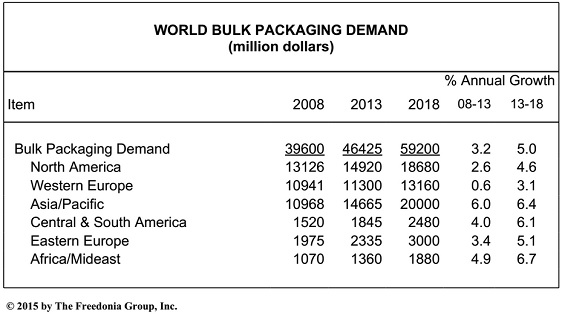World bulk packaging demand to exceed $59 billion in 2018
Growth expected to outperform the 2008-2013 period across the globe; China decelerates as North America follows rising food, beverage, chemical and pharmaceutical production.
Latest Material Handling News
Lucas Watson appointed CSO for Körber’s Parcel Logistics business in North America Hyster recognizes Dealers of Distinction for 2023 Carolina Handling names Joe Perkins as COO Walmart deploying autonomous lift trucks at four of its high-tech DCs Kathleen Phelps to join FORTNA as chief financial officer More NewsWorld demand for bulk packaging is projected to increase 5% annually to $59.2 billion in 2018.
This will be an improvement over the 2008-2013 period, when growth in demand was particularly sluggish in the world’s most developed markets, especially Japan and Western Europe. Accelerating growth in global manufacturing activity will be the primary driver for demand gains. These and other trends are presented in World Bulk Packaging, a new study from The Freedonia Group, a Cleveland-based industry market research firm.
According to analyst Mike Richardson, gains in the U.S. will be driven by increased demand in food and chemical applications, as growth in both food and beverage processing and chemical and pharmaceutical production are expected to accelerate. These same developments are expected to drive demand in Western Europe and Japan, though gains will be somewhat muted as the manufacturing slump in these areas has been more enduring, and the recovery is expected to be less explosive.
The report anticipates flexible bulk packaging will register slightly faster growth than rigid packaging. Gains in flexible bulk packaging will be led by film wrap and FIBCs. “Film wrap has gained market share from strapping in some applications like securing pallets and other packaging formats during shipment,” Richardson said. “Also, multi-packs and other formats seen in warehouse-style stores have encouraged its use.”
FIBCs will register strong advances due to the advantages they offer in terms of efficiency advantages, loading and unloading products, and their ability to handle greater quantities of product per container. In rigid bulk packaging, RIBCs and material handling containers are projected to register faster growth than the somewhat more established drums and pails. Drums will remain the largest rigid bulk packaging product type, even as they surrender market share to FIBCs and competitive rigid formats.
“The waning popularity of drums is mainly attributable to the waning popularity of fiber drums,” Richardson said. “Both plastic and steel are expected to register fairly decent growth, in part due to their durability and reusability. Fiber drums, which are reusable in some instances – especially with liners – are more widely used in single-trip uses.” Richardson observed that users are moving to the other drum types or different container types, although fiber drums’ lower price and suitability for some applications will allow them to maintain a market presence.
For bulk packaging overall, the fastest gains will be in developing regions such as the Africa/Mideast region, the Asia/Pacific region, and Central and South America. India and Indonesia will be among the fastest growing national markets, according to the report. “Growth in China’s manufacturing sector is beginning to decelerate after a few decades of world-leading growth,” Richardson said, “but advances in bulk packaging demand in China will still be among the world’s fastest.”


Article Topics
Latest in Materials Handling
Materials Handling Robotics: The new world of heterogeneous robotic integration Lucas Watson appointed CSO for Körber’s Parcel Logistics business in North America Hyster recognizes Dealers of Distinction for 2023 Carolina Handling names Joe Perkins as COO C-suite Interview with Keith Moore, CEO, AutoScheduler.AI: MODEX was a meeting place for innovation Walmart deploying autonomous lift trucks at four of its high-tech DCs Coles shops big for automation More Materials HandlingSubscribe to Materials Handling Magazine

Find out what the world's most innovative companies are doing to improve productivity in their plants and distribution centers.
Start your FREE subscription today.
April 2024 Modern Materials Handling

Latest Resources










